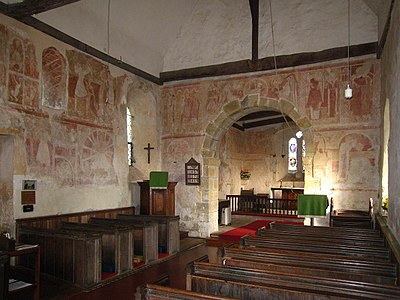St Botolph's Church, Hardham
| St. Botolph's Church, Hardham | |
|---|---|

The Romanesque paintings
|
|
| 50°56′55″N 0°31′22″W / 50.948551°N 0.522789°WCoordinates: 50°56′55″N 0°31′22″W / 50.948551°N 0.522789°W | |
| Location | Church Lane, Hardham, West Sussex RH20 1LB |
| Country | United Kingdom |
| Denomination | Church of England |
| Website | Arun Churches |
| History | |
| Founded | 11th century |
| Dedication | St. Botolph |
| Architecture | |
| Status | Parish church |
| Functional status | Active |
| Heritage designation | Grade I |
| Designated | 15 March 1955 |
| Style | Anglo-Saxon; Norman |
| Administration | |
| Parish | Hardham |
| Deanery | Rural Deanery of Petworth |
| Archdeaconry | Horsham |
| Diocese | Chichester |
| Province | Canterbury |
| Clergy | |
| Vicar(s) | Fr. David Twinley |
St Botolph's Church is the Church of England parish church of Hardham, West Sussex. It is in Horsham District and is a Grade I listed building. It contains the earliest nearly complete series of wall paintings in England. Among forty individual subjects is the earliest known representation of St. George in England. Dating from the 12th century, they were hidden from view until uncovered in 1866 and now "provide a rare and memorable impression of a medieval painted interior". The simple two-cell stone building, with its original medieval whitewashed exterior, has seen little alteration and also has an ancient bell.
Hardham village is just off the main A29 road, which is "excitingly" separated from the village lane by narrow hedges. The A29 follows the course of Stane Street, an important Roman road, and Hardham was the first posting station after leaving the Roman city of Noviomagus Reginorum (present-day Chichester). Hardham was recorded in the Domesday survey of 1086 as Heriedham, but a church was not described.Hardham Priory was founded nearby in 1248.
The church is late Saxon or early Norman. Despite its omission from the Domesday survey, the present building is often considered to be 11th-century; all sources agree that it was complete by 1125 at the latest. The design, described as "primitive" and simple, appears to belong solely to the very early Norman style rather than "wavering between Saxon and Norman" like some contemporary churches; but the dedication to St Botolph is generally associated with Saxon churches. Some stones and tiles used by the Romans for their nearby buildings were incorporated into the fabric of the building, especially in the chancel.
...
Wikipedia
